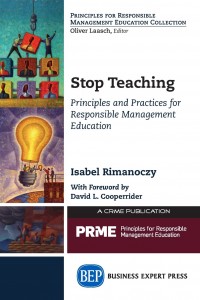‘Stop Teaching’ Isabel Rimanoczy about her PRME collection book
 Stop Teaching. I will agree that the title is puzzling, but it is one that, after some hesitation, I selected intentionally. My rationale was that we have a model of higher education that has endured for centuries oblivious to technical progress and cultural evolution, regardless of geography and of the changing profile and expectation of the students – let alone the shifting requirements of the marketplace—and it needs a provocative call to shake things up.
Stop Teaching. I will agree that the title is puzzling, but it is one that, after some hesitation, I selected intentionally. My rationale was that we have a model of higher education that has endured for centuries oblivious to technical progress and cultural evolution, regardless of geography and of the changing profile and expectation of the students – let alone the shifting requirements of the marketplace—and it needs a provocative call to shake things up.
The thought originated in an oil painting I came across, entitled The Children’s Class, by French artist Henri Jules Jean Geoffroy, and painted in 1889. It features a classroom of the time, and I could see desks lined up in rows, with students sitting facing the blackboard, and their papers scattered on their desks. Some concentrated on their notebooks, others were looking over someone else’s shoulder, one was daydreaming, and another was holding his head, immersed in his own worries, judging from the expression on his face.. Fast forward to today. Students seated in rows, whether in modern amphitheater-style or at tables, all facing the front of the room, maybe fewer papers on the desks, but notebooks of a different type, some daydreaming, or fumbling discreetly on their phones… This seems like a description of any day in most of the higher education classes across the globe.
Is this an effective way to prepare our students who are facing the most significant planetary challenges in human history: social, ecological, economic, and health-wise? The progress humankind has made in creating a more comfortable and a better life has been of benefit to a relatively small minority, while most of the 7 plus billion of people on the planet get to endure some of the costs: waste that accumulates without us having a clear sense of how to dispose of it, nor the long term impact of its components; pollution or depletion of land and water resources, which, with air and community, are the fundamentals we need to survive. We are caught unconsciously in an economic model that follows the take-make-waste cycle, something that simply doesn’t exist in Nature, where everything is interconnected and supports the subsistence of the whole ecosystem. The good news is that the economic model was created by us, humans, and it means that we can change it – now that we know the experiment hasn’t fared so well.
Higher education has a unique opportunity to accelerate change, because in today’s classroom we are dealing with young people who have the enthusiasm, the creativity, and the motivation to be engaged in re-shaping their world. They don’t see it as an option – because, as one student put it – “It’s our world!”. But here is the trick: not all of them may have the character to spontaneously take an active stance. It must, therefore, be up to educators to foster, inspire, and nurture this agency.
Think for a moment. What do students look like when they are planning a party, a sporting event, or some celebration? They are excited, they don’t mind skipping sleep, They are passionate and get things done. They have both fun and a purpose. How can educators generate comparable energy in our classroom, and awaken that potential?
After years of designing and implementing corporate leadership development programs with the adult learning methodology Action Reflection Learning, it was natural to apply the same principles in my classroom. I wanted to create relevance, opportunities for social learning, transformational experiences, and safe learning environments. I wanted to develop critically reflective individuals, who would expand their self-awareness, uncovering their mental maps and models, all the while developing self-confidence, and engaging in a holistic way in our dialogues. I wanted to help them to develop a systemic lens through which to view the world, independently of the topic, and to foster ways to bring out their tacit knowledge. Following what I had experienced and found powerful in corporate training, I brought it into the classroom, and created a setting where it was not about teaching, but about facilitating learning. A very different perspective, and a shift in the traditional educational power structure. But what better way to develop change agents, than supporting, inspiring, mentoring and coaching students to become the shapers of a better world? Isn’t that what coaches do, what parents do as they help their young become the best they can be?
We need to reinvent how we produce, how we obtain resources, distribute, communicate, transport, eat, dispose, entertain and connect with each other. In two hundred thousand years Homo sapiens still hasn’t figured out how to live together in the planetary ecosystem, to collectively thrive and be the best we can be. But there is good news. This is the first time in history that we actually have the tools, the technology and knowledge to solve the big problems of our time. I propose to shift from teaching to engaging and facilitating a profound learning in our youth, empowering them to take action and tackle in new, creative ways the challenges that abound. Not in the future – right now.
